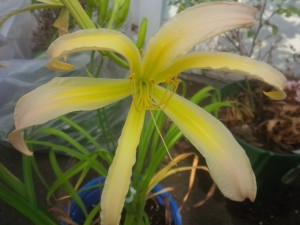Not long ago I went to Grace Gardens, in Geneva, NY, a magical daylily garden and nursery. It was early July, just before peak daylily bloom, but thousands of blossoms were already open for business. The array of colors and forms was breathtaking. I found it impossible to leave without a handful of new daylily plants and the owners were generous enough to include a “surprise” plant in my package. The “surprise” was a yellow-peach, spider-form daylily.
I have lots of daylilies, but this particular “spider” was the first in that form. It has turned out to be the best kind of surprise—something that I wouldn’t have chosen on my own, but now find irresistible.
Most flowers labeled “spider form” feature relatively slender petals that flare out from the center like the legs of a common arachnid. The American Hemerocallis society, which regulates the daylily world, defines a spider-type daylily as “A flower whose petal length is four times the petal’s width or more.”
The spider trait can be found in the species or wild forms of some plants, as with certain of the crinum lilies, beloved of American southerners. Other times it appears as the result of selective breeding, turning up in cultivated varieties or hybrids. My new daylily is an example of one such variety. Occasionally flower parts other than petals give rise to the spider designation. Lycoris radiata or red spider lily, for example, is a member of the amaryllis family distinguished by long, arching red stamens that project outward from the center.
I have noticed that the spider flower forms are especially popular with minimalists, contemporary-style garden designers, artists and those fascinated with the unusual. For people who are simply wild about a particular genus or species—like the proprietors of Grace Gardens—spider forms are simply essential components of a complete plant collection.
My mother, who was rather artistic, but certainly no minimalist, had a fondness for spider chrysanthemums. While these particular “spiders” feature the requisite slender petals, they are completely different in style than the relatively simple spider daylilies. Many feature globular or dish-shaped heads packed tight with scores of thin petals. While you can buy spider-form garden mums, spiders seem to be most numerous in the cut flower trade. Like other mum types, they combine colorful petals and interesting form with long vase life. Many brides have invited these well-mannered spiders into their wedding bouquets.
Now that dahlias are once again in fashion, many dahlia lovers have discovered or rediscovered spider-form dahlias. While not an official category of the American Dahlia Society, there are some “spiders” in the Cactus, Semi-Cactus, Novelty and Single categories. Most are closer in style to the spider mums than spider daylilies, with many-petaled flowerheads full of slender, recurved petals. Some have so many of those petals that they appear almost shaggy. ‘Black Spider’, which is actually dark red, is part of the bountifully endowed spider-form dahlia brigade. However, less common varieties, like ‘Verrone’s Sophie’ boast a simpler array of eight thin petals.
If you want something indisputably spidery, try spider flower or Cleome hassleriana. These reliable annuals grow between three and six feet tall, with stems topped by racemes or flowerheads of pink, purple or white flowers. The spidery feature is the array of protruding stamens that project aggressively outwards from the flowerheads. These give the blooms just the right exotic appearance and amply justify the plant’s common name. The big, bold leaves are palmate and also conceal the spider’s sting—sharp thorns at the base of each leaf stalk. These may make humans wary, but they are not enough to deter the hummingbirds and butterflies that dine on the nectar offered by these spiders. Spider flowers are notorious self-seeders, but this means that you won’t have to plant them again after the first year.
I used to worship at the shrine of big, fat petals and fluffy, flouncy flowers. Now, with my new spider daylily firmly ensconced in the garden, I think I may indulge in some much needed variety and find it some similarly configured friends.

